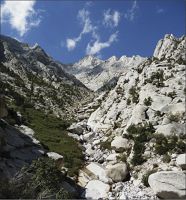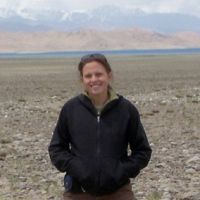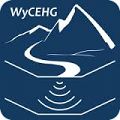SSCZO’s Cliff Riebe and Claire Lukens shed light on the role of sediment size in landscape evolution
26 Jan 2016
News Source: Proceedings of the National Academy of Sciences
Riebe et al. combine old isotopic techniques in new ways, with big results showing connections between sediment size, erosion, topography, and climate
Earth scientists Cliff Riebe, Leonard Sklar, Claire Lukens, and David Schuster are breaking ground on, well, broken ground. Riebe et al. combined two widely used sediment tracing techniques on various sediment sizes in a mountain stream and created a new way of studying patterns of where, when, how fast, and how hillslopes and drainages are eroding and evolving. And they piloted their new approach in Inyo Creek, located in the Sierra Nevada. Their newly published paper was featured in the December 22, 2015, issue of the Proceedings of the National Academy of Sciences (PNAS), with a field photo taken by Lukens on the cover of the issue.
Detrital thermochronometry was one of those techniques, which uses isotopes with internal time clocks that reset at certain temperatures. The team fingerprinted the elevations of hillslopes where sediment originally came from using ages revealed in U-Th/He isotopes from apatite mineral grains.
And cosmogenic nuclides in the sediment were analyzed to show when that sediment originally was exposed on a hillslope and eroded. The isotope 10Be starts forming when rock and sediment particles are within a few centimeters of the Earth's surface and are bombarded by cosmic rays in the atmosphere, creating a ticking erosional clock. The team employed this technique to understand the average erosion rates of the hillslopes and drainages around their sample site.
Riebe et al. found that colder, steeper, and less vegetated slopes produce coarser sediment, and that coarser sediment erodes faster into the drainage network. Both the size and supply rate of sediment influence the pace of river incision and landscape evolution.
Learn more about the project and authors from the University of Wyoming news team, or read the entire paper in the PNAS Issue.
Written by Michelle Gilmore
News Source:
READ MORE from Proceedings of the National Academy of Sciences >>
News Category:
RESEARCH |
PUBLICATIONS |
PEOPLE |
EDUCATION/OUTREACH
Publications
2015
Climate and topography control the size and flux of sediment produced on steep mountain slopes. Riebe, C., Sklar, L., Lukens, C., and Shuster, D. (2015): Proceedings of the National Academy of Sciences
Explore Further





